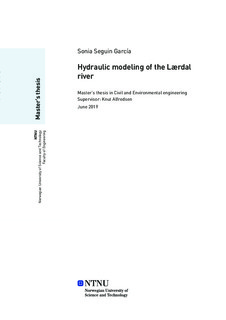| dc.description.abstract | Hydraulic modeling is a useful tool to analyze the impacts from changes in the flow and in the morphology of a river. To achieve accurate results it is necessary to collect detailed data of the topography of the area, especially of the river channel. In this type of landform, conventional red LiDAR data is not suitable as the near-infrared wavelength is largely absorbed by water bodies. Nevertheless, the increasing availability of high precision remote sensing techniques allows to gather this data by using green light in a so-called ALB process.
In this project, both red and green LiDAR data were processed in order to create an accurate hydraulic model for the river of Lærdal, which is listed as a Norwegian national salmon river. However, some flood protection works should be carried out in this river due to the high risk of flooding in the area. In order to analyze this, inundation maps for a 200-year recurrence interval were prepared in HEC-RAS, both for the current situation and for the case in which flood protection works are included in the river. The modifications to protect the area against floods were based on the NVE plans and include the construction of a wall in the lower part of the river and some excavations to modify the shape of the river.
The green LiDAR data used to set up the hydraulic model was validated first. Comparisons of this data against red LiDAR and manual GPS measurements proved that the differences in elevation obtained with these three systems were, except in some local areas, within 10cm.
Subsequently, the hydraulic model created was calibrated against the measured water surface elevation collected the day when the green LiDAR flight took place. The calibration was performed by changing the Manning’s n coefficient of the river bed, since it was proved to be the most influential parameter. A final value of 0.035 offered the most suitable results.
The simulations run with the final model proved that a 200-year flood event in the village could be prevented with a flood protection wall about 1m high in most of its extension when the effects of climate change on the hydrological parameters of the area are not considered. | |
